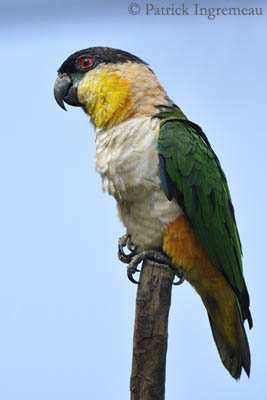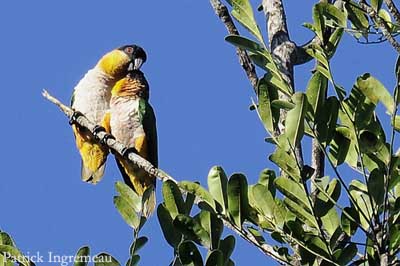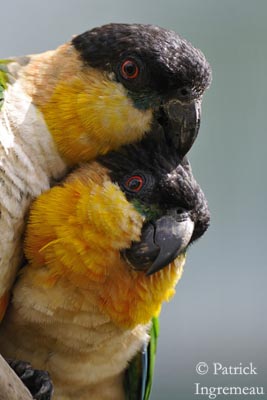
Black-headed Parrot
Pionites melanocephalus
Psdittaciforme Order – Psittacidae Family
OTHER NAMES:
Black-capped Parrot
Black-crowned Parrot
BIOMETRICS:
Length: 23 cm
Weight: 130-170 g
LONGEVITY: About 30-40 years
DESCRIPTION:
The Black-headed Parrot is a small and brightly coloured parrot of the Amazon Basin.
The adult male has green upperparts on back, wings and short, rounded tail. On the wings, the primaries are dark blue.
On the underparts, the upper breast is pale orange-yellow. Lower breast and belly are whitish. Thighs, flanks and undertail coverts are orange-yellow. The rectrices are olive-yellow.
On the head, forehead, crown and nape are black. The hind neck is rufous-orange. Lores are green. Face, neck sides and throat are pale orange-yellow.
The hooked bill is blackish. The eyes are orange-red with grey eye-ring. Legs and feet are grey.
Both sexes are similar.
Immature is rather pale yellow on breast and belly, and thighs are streaked with green. The eyes are dark brown.
DIET:
The Black-headed Parrot feeds mainly on seeds, pulp of varied fruits, flowers and leaves. It may take some insects, but it is primarily vegetarian.
PROTECTION / THREATS / STATUS:
The Black-headed Parrot is fairly common in its range. This species is not threatened at this moment.
Fr: Caïque maïpourri
All : Grünzügelpapagei
Esp: Lorito Chirlecrés
Ital: Caicco testanera
Nd: Zwartkopcaique
Russe: Черноголовый Попугай
Sd: Svarthuvad vitbukspapegoja
Photograph by Patrick Ingremeau
TAMANDUA
Text by Nicole Bouglouan
Sources:
PARROTS OF THE WORLD – An Identification Guide – by Joseph M. Forshaw – Princeton University Press – ISBN 0691092516
PORTRAITS D’OISEAUX GUYANAIS - Groupe d'étude et de protection des oiseaux en Guyane (GEPOG) - Ibis rouge éditions - ISBN: 2844501842
HANDBOOK OF THE BIRDS OF THE WORLD vol 4 by Josep del Hoyo-Andrew Elliott-Jordi Sargatal - Lynx Edicions - ISBN: 8487334229

The Black-headed parrot has two subspecies:
P.m. melanocephala
P.m. pallida has whiter breast and belly, and paler hind neck and mantle.
VOICE: SOUNDS BY XENO-CANTO
The Black-headed Parrot is very vocal. In flight, it gives high-pitched “cleeeooo…” or “heeyah…”, and also screeching “weech-weech…”, varied shrieks and squawks. When threatened, it utters shrill calls.
It often sings sheltered into the vegetation, and some calls also include whistles.
HABITAT:
The Black-headed Parrot frequents the humid tropical forests, but also sometimes tall secondary growths, clearings with scattered trees and seasonally flooded woodlands. It is visible up to 1000 metres of elevation.
RANGE:
The Black-headed Parrot is endemic to the Amazon Basin where the species occurs in the half-northern part of this area. It is common in Guyana.
BEHAVIOUR:
The Black-headed Parrot feeds on seeds, fruits, flowers and leaves from several plants’ species. It may forage in the canopy or at lower level, using its bill as a “third hand” for climbing into branches and bushes.
Usually, this parrot lives in small groups of 10 to 30 birds, or in pairs. While they are feeding, two birds are required as sentinels, in order to prevent a potential danger.

The Black-headed Parrot roosts communally in holes in trees. It is resident within its range, except in Guyana where it performs some nomadic movements according to the food resources.
This parrot is noisy when in small flocks. In the early morning, they call loudly while they perform their greeting displays from exposed perches, with raised wings.
If disturbed, they fly away, flying into the canopy or just above.
FLIGHT:
The Black-headed Parrot has rapid, direct flight, with relatively deep wing beats. We can hear an audible whirring produced by he wing feathers.

REPRODUCTION:
The breeding season varies according to the geographic range.
The Black-headed Parrot nests in cavities such as hollows in trees, old woodpeckers’ nests or other natural cavity.
The female lays 2 to 4 eggs, and incubation lasts about 25 days.
The nesting behaviour of this species is poorly known.